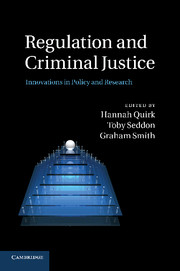Book contents
- Frontmatter
- Contents
- List of figures and tables
- Notes on contributors
- Foreword
- Acknowledgements
- 1 Regulation and criminal justice: exploring the connections and disconnections
- PART I Regulation and criminal justice: framing the debate
- PART II Criminal justice as regulation: responsivity, alternatives and expansion
- PART III Regulation of criminal justice: monitoring, effectiveness and accountability
- Index
- References
1 - Regulation and criminal justice: exploring the connections and disconnections
Published online by Cambridge University Press: 04 February 2011
- Frontmatter
- Contents
- List of figures and tables
- Notes on contributors
- Foreword
- Acknowledgements
- 1 Regulation and criminal justice: exploring the connections and disconnections
- PART I Regulation and criminal justice: framing the debate
- PART II Criminal justice as regulation: responsivity, alternatives and expansion
- PART III Regulation of criminal justice: monitoring, effectiveness and accountability
- Index
- References
Summary
This book explores the relationship between regulation and criminal justice. It comprises a selection of papers presented to an international seminar series hosted by the School of Law, University of Manchester, UK, between November 2007 and February 2009. The majority of seminar participants were criminologists and interdisciplinary scholars involved in research across a range of criminal justice fields, invited to engage in a ‘long conversation’ with several regulation scholars and practitioners. One of the strengths of interdisciplinary discourse is the cross-fertilization of ideas between specialisms that facilitates comparative study and knowledge transfer. Socio-legal research and analysis, in explanatory and normative forms, has played a crucial part in the recent development of regulation (Morgan and Yeung 2007) and criminal justice (Sanders et al. 2010) as distinct areas of scholarship. But, as we will see, the two areas do share some common heritage, and so it is not surprising that connections have been established – most persuasively in the fields of policing (Ayling et al. 2009; Johnston and Shearing 2003) and restorative justice as an alternative to penal orthodoxy (Braithwaite 2002).
Grabosky (see Chapter 4, this book) describes regulation as a ‘mansion with many rooms’, an image that captures its scope, multifaceted character and conceptual diversity. Contemporary regulation discourse is rooted in public sector innovation dating back some three decades, which led to the transformation of governance in, and between, democratic polities regionally and globally (Levi-Faur 2005; Majone 1996).
- Type
- Chapter
- Information
- Regulation and Criminal JusticeInnovations in Policy and Research, pp. 1 - 24Publisher: Cambridge University PressPrint publication year: 2010
References
- 2
- Cited by



